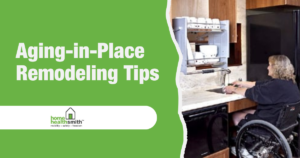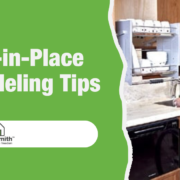Aging-In-Place Remodeling Tips
Aging in place is much more appealing for many people compared to moving into a care facility. Maintaining independence and self-esteem, staying connected to the community, and affordability are just three important ways that seniors benefit from remaining in their own homes.
However, they may need to make adjustments to their home and lifestyle to make this goal a realistic one.
Home Healthsmith works with people and their families to make homes safer. Before committing to a remodeling or installation process, we recommend carefully considering each of the recommendations below.

Key Considerations for Aging-In-Place Remodeling
Knowing when and how to remodel the home to make it safer can be challenging for everyone involved. Here are just three indications someone has reached the point of requiring additional support:
- Navigating personal hygiene tasks is becoming troublesome due to not being able to navigate the shower or bathtub well.
- Making meals has become a chore because they are having a hard time navigating the kitchen and using appliances.
- Recent falls due to poor balance or tripping over furniture or throw rugs.
While seeing a loved one struggle with these tasks can be heartbreaking, the good news is that even slightly remodeling the home can make a big difference. Having a home assessment to determine the remodeling steps or equipment that would make the most positive difference is the first step in the process. Home Healthsmith will work with you to conduct this evaluation and outline what products to consider to make each area of the home more accessible.
Below are some of the areas that may cause trouble for someone aging in place and the products that could pose a solution.
Modify entryways and exits
People who use a wheelchair or walker may no longer be able to maneuver in and out of their entryways and exits. Widening doorways is a simple solution to this common problem.
Replacing steps with a wheelchair ramp is another solution to getting in and out of the house with ease.
Arthritis and other inflammatory joint disorders can make walking up and down steps difficult for people who use a cane for mobility. Replacing the steps with a ramp and installing handrails is often a better alternative. Stairlifts should also be considered as well as they ensure a safe way to get up and down stairs inside or outside your home.
Make bathrooms safe and accessible
Slippery floors and not having anything to hold onto are two of the leading causes of injuries that occur in the bathroom.
Bathroom safety products, like no-slip rugs and grab bars near the shower or bathtub and toilet, can prevent serious accidents.
Raising the height of the toilet seat and/or making it possible to walk into the bathtub without having to step over anything also increases independence.
Kitchen modifications for accessibility
People who use wheelchairs or walkers, or those who are simply unsteady on their feet, typically cannot reach the items they need on kitchen countertops or in the cabinets. Cooking nutritious meals for themselves becomes extremely challenging under these circumstances.
Lowering the cabinets and creating a ground-level space to store pots, pans, and spices can make it easier for people to continue cooking for themselves. However, this option can be very expensive. A more cost-effective approach is a Drop Down Kitchen Cabinet, which is controlled by a switch and drops down cabinet shelves to counter-top height.
Replacing current appliances like a coffee pot or microwaves with new equipment designed with accessibility in mind is another possibility. Lever-style handles at eye level also make navigating the kitchen much less frustrating for those with mobility limitations.
Bedroom and living space consideration
Something as simple as making sure the bedroom has enough lighting can prevent accidents from happening in the home. Residential elevators or stair lifts can also be a good idea for multi-level homes because it eliminates the need to wait for someone to assist them with getting from one place to another.
Making the bedroom more accessible should be a priority when aging-in-place is the goal. For example, the bed and dressers may currently be in a location that makes it difficult to move through the bedroom without bumping into something.
We encourage families to minimize furniture and accessories in the bedroom to avoid a collision or dropping objects that could break and cause injuries.

Choose the Right Products and Contractors for Smooth Aging-In-Place Remodeling
Not every company that offers aging-in-place products offers the quality families need to be confident their loved one is safe at home.
Home Healthsmith invites you to contact us to request a free safety assessment today. Please let us know if you are also interested in learning more about home safety products, such as residential elevators, stair lifts, wheelchair ramps, grab bars for the bathroom, and any other product you are considering installing.
When we arrive for your Home Assessment, we will discuss our products and installation process before completing a safety audit of every room in your home. You will also receive a free cost estimate and references you can contact to learn more about the quality of our work and customer service.





